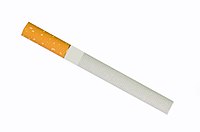
Photo from wikipedia
The role of second hand smoke (SHS) exposure on ulcerative colitis is not known. Our aim was to examine the effects of α‐lipoic acid (ALA), chronic aerobic (AE) or resistance… Click to show full abstract
The role of second hand smoke (SHS) exposure on ulcerative colitis is not known. Our aim was to examine the effects of α‐lipoic acid (ALA), chronic aerobic (AE) or resistance exercise (RE) on SHS exposed rats with colitis. Sprague‐Dawley male rats (150‐200 g, n=54) were selected for colitis induction. Among the colitis groups, one group was exposed to SHS (6 d/wk, 4 cigarettes/d) and the other was not. The SHS group was divided into subgroups as follows: sedentary; AE (swimming; 3 d/wk); and RE (climbing with weight; 3 d/wk). After 5 weeks, colitis was induced by intrarectal acetic acid. All groups had subgroups that were given subcutaneously ALA (50 mg/kg per day) or vehicle for 3 days. Following decapitation, colon tissues were sampled to examine malondialdehyde (MDA) and glutathione (GSH) levels, myeloperoxidase (MPO) activity, luminol and lucigenin chemiluminenscence, macroscopic scoring and histologic examination. ANOVA and Student's t‐test were used for statistical analysis. The increased macroscopic and microscopic scores, MPO, MDA, luminol and lucigenin measurements in colitis and SHS‐colitis groups were decreased via ALA (P<.05‐.001). AE declined macroscopic and microscopic scores, MDA, lucigenin compared to colitis and SHS‐colitis groups (P<.01‐.001). RE reduced microscopic score, MPO, MDA, luminol, lucigenin (P<.05‐.001) that were increased with colitis. Decreased GSH levels (P<.01) in the SHS‐colitis group approached to control levels when given ALA. According to our results SHS and colitis induction increased inflammatory damage. SHS did not worsen it more than colitis. Our results suggest that ALA, AE or RE might be protective for SHS exposed ulcerative colitis conditions.
Journal Title: Clinical and Experimental Pharmacology and Physiology
Year Published: 2017
Link to full text (if available)
Share on Social Media: Sign Up to like & get
recommendations!